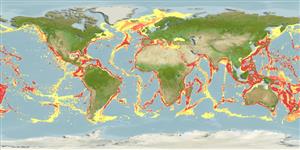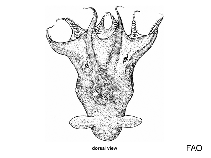Vampyroteuthis infernalis Chun, 1903
Vampire squid| Native range | All suitable habitat | Point map | Year 2050 |

|
| This map was computer-generated and has not yet been reviewed. |
| Vampyroteuthis infernalis AquaMaps Data sources: GBIF OBIS |
Google image | No image available for this species;
drawing shows typical species in Vampyroteuthidae.
Classification / Names প্রচলিত নাম সমূহ | প্রতিনাম সমূহ | CoL | ITIS | WoRMS
Cephalopoda | Vampyromorpha | Vampyroteuthidae
Environment: milieu / climate zone / গভীরতার পরিসীমা / distribution range বাস্তুসংস্থান
ভাসমান; গভীরতার পরিসীমা 100 - 3000 m (সূত্র 110525), usually 900 - 1100 m (সূত্র 106682). Tropical; 44°N - 35°S, 180°W - 180°E (সূত্র 96968)
Distribution দেশ সমূহ | এফ এ ও এলাকাসমূহ | বাস্তুতন্ত্র | দৃষ্টিগোচর | প্রচলন
Circumglobal in tropical and temperate waters.
Length at first maturity / আকৃতি / Weight / Age
পরিপক্কতা : Lm ? range ? - ? cm Max length : 13.0 cm ML পুরুষ/ লিঙ্গ অনিধর্ারিত ; (সূত্র 96968)
Life cycle and mating behavior পরিপক্কতা | প্রজনন | ডিম ছাড়া | Eggs | ডিম্বধারন ক্ষমতা | Larvae
Main reference
সূত্র সংখ্যা | সমম্বয়কারী | সহযোগী
Jereb, P., C.F.E. Roper, M.D. Norman and J.K. Finn 2014 Cephalopods of the world. An Annotated and Illustrated catalogue of Cephalopod species known to date. Vol. 3. Octopods and vampire squids. FAO Species Catalogue for Fishery Purposes 3(4):370p. (সূত্র 96968)
IUCN Red List Status
(সূত্র 130435: Version 2025-1)
CITES status (সূত্র 108899)
CMS (সূত্র 116361)
Threat to humans
Human uses
| FishSource |
হাতিয়ার
আরো তথ্য
Max. ages / sizes
Length-weight rel.
Length-length rel.
Length-frequencies
Mass conversion
প্রাচুর্য
ইন্টারনেট সুত্র
BHL | BOLD Systems | CISTI | DiscoverLife | FAO(Publication : search) | Fishipedia | GenBank (genome, nucleotide) | GloBI | Gomexsi | Google Books | Google Scholar | Google | PubMed | জীবন বৃক্ষ | Wikipedia (Go, অনুসন্ধান ) | জুলজিকাল রেকর্ড



